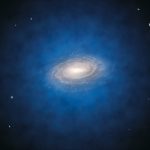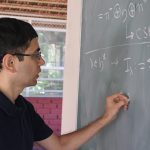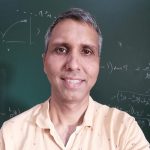Ranjan Laha’s group works on intriguing questions in astroparticle physics

As we walk down the road to Janta Bazaar from the Physical Sciences building, Ranjan Laha struggles to remember what in particular sparked his interest in science, or if such a spark ever happened. “I don’t know why I got interested in science. I just liked science in general, especially maths and physics. I think I was never very good at it, but I always liked it.”
Ranjan joined IISc in 2006 as a Master’s student and went on to do his PhD from the Ohio State University, followed by postdocs at Stanford University (USA), University of Mainz (Germany), and CERN (Switzerland). He is now an Assistant Professor in the Centre for High Energy Physics (CHEP) at IISc.
We continued walking as he dragged along his bicycle – his most common mode of transport inside the Institute – to a repair shop to fix a flat tyre. After handing over the bicycle to the shopkeeper, we started walking back to his office in CHEP.
Along the way, Ranjan recollects how he had always been curious. He used to wonder what made physicists like Newton and Einstein so famous that their names were remembered long after they died. Flicking the keychain of his bicycle, he says: “Look at this keychain – you throw it up, it comes down. In this context, Newton did two things. He explained why this happens. And then he connected it [to the real world] by saying that this and the Earth going around the sun are the same thing.”
Even before Newton, Ranjan points out, people may have wondered what made things fall down. They must have had some kind of notion of what we now know as gravity and may have even called it by some other term. It was only when Newton put it down in scientific terms in the 1600s that people understood it better.
Today, Ranjan adds, we might be at a similar inflection point of understanding what makes up dark matter.
“Decades of astrophysical and cosmological observations have shown that there is a form of matter which, as far as we know, does not interact with light. This is called dark matter,” explains Ranjan. “There are many, many pieces of evidence for [the existence] of dark matter, but we don’t have the answer to the simplest possible question: What is dark matter?”
A popular candidate that may constitute dark matter, or some part of dark matter, is Primordial Black Holes (PBH). This possibility is currently being explored by researchers all over the globe, including Ranjan’s group.
Typically, black holes are formed by the death of massive stars; their entire mass implodes into an extremely dense, compact region. PBHs, however, are believed to have formed in the very early universe, much before the formation of stars.
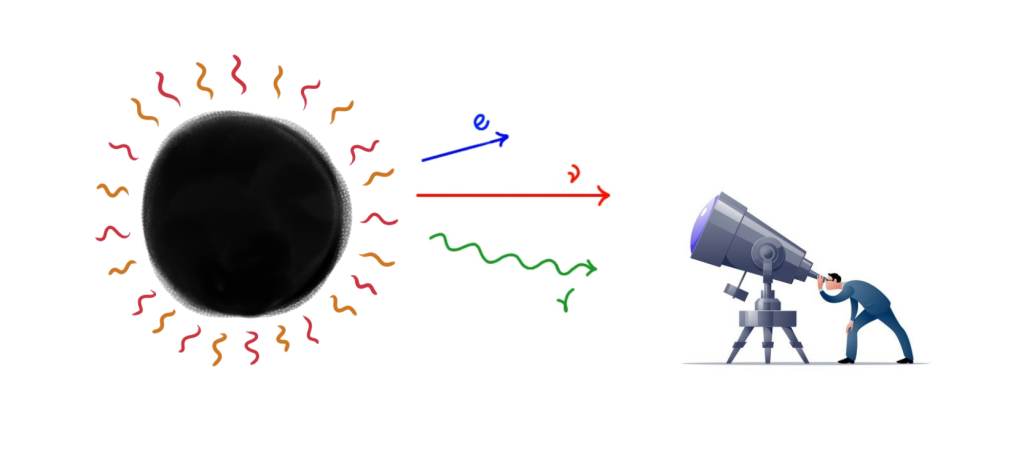
Less than a second after the Big Bang – the explosion that created the universe – space was not entirely homogeneous. Some regions were much denser than others. Scientists believe that this difference in density led to a collapse that was brought about by gravity, forming primordial black holes. “General Relativity tells us that if you take an object and squeeze it enough, at some point, it will turn into a black hole,” notes Ranjan.
Although PBHs could have only formed right after the Big Bang, they are thought to be exceptionally stable – those with mass greater than 1012 kg are speculated to have survived even today. The ones with lesser mass may have evaporated due to the Hawking radiation, a kind of thermal radiation emitted by black holes due to certain quantum effects.
“PBHs can be dark matter because they have a lot of the properties that you require in dark matter,” says Ranjan. For example, dark matter makes up 25% of the energy density of the universe. It is theoretically possible for PBHs to also make up a similar percentage of the energy density of the universe. This theory can be tested by constraining the mass of PBHs that may partly constitute dark matter. Ranjan’s group is working on stricter restrictions on the possible masses of PBHs – based upon Hawking radiation – that may compose dark matter.
Searching for neutrinos
About 25% of dark matter, along with 70% of dark energy, makes up 95% of the energy density of the universe. Yet, the Standard Model of particle physics – which explains the interaction of fundamental building blocks of matter – is unable to point to any particles that may constitute dark matter. Thus, it is successful in explaining only 5% of the universe. This has led scientists to formulate what is called physics Beyond the Standard Model (BSM).
Among other things in BSM physics, Ranjan’s group is actively studying fundamental particles called neutrinos, which have certain properties that necessitate BSM explanations.
“Neutrinos are extremely weakly interacting particles that, according to the Standard Model, are massless, just like a photon,” explains Ranjan. Consequently, neutrinos usually pass through matter unimpeded, unlike photons – particles that make up light – which may get ‘blocked.’ This makes the detection of neutrinos extremely difficult. Only powerful observatories – like the IceCube Neutrino Observatory located at the South Pole – have been able to detect high-energy or cosmic neutrinos. Yet, their origin has remained mostly elusive.
A lot of science works by the process of elimination. For example, scientists have suggested that galaxy mergers – a violent collision between two or more galaxies – are able to accelerate particles to very high energies and may theoretically produce cosmic neutrinos. But Ranjan’s team has found no significant link between such galaxy mergers and these high-energy neutrinos. They showed that these galaxy mergers are not the source of the neutrino emissions thus far observed by IceCube. The hunt for their origin, therefore, is still ongoing.
Tracing the origin of these neutrinos is important. Just like how we can learn different things about the same slice of universe when looking at the visible light it emits versus X-rays, new details can be revealed when we peer at the slice through the eyes of cosmic neutrinos, especially because of their weakly interacting nature. For example, tracing their path could lead us to black holes, supernovae, and various other intense events in the cosmos that may not necessarily be detected using other signatures.
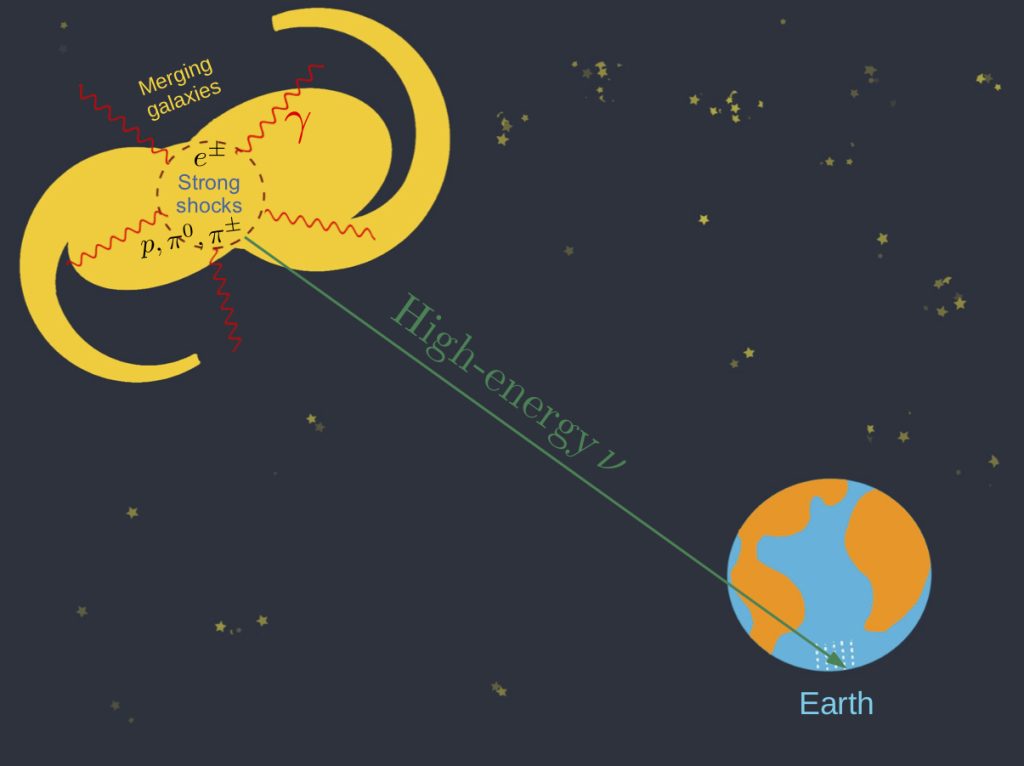
The other mystery about neutrinos surrounds their mass. In the Standard Model, fundamental particles like electrons and quarks (particles that make up protons and neutrons) gain mass through a process called the Higgs mechanism. The Higgs field is a quantum field that permeates all of space. Interaction with this field gives particles like electrons (a fundamental particle) their mass. Photons do not have mass because they do not interact with the Higgs field. Neutrinos do not interact with the Higgs field at all. “[However], we know from both lab experiments and astrophysical measurements, that neutrinos [do] have mass. Where or why does it get its mass from? Nobody knows the answer. [In fact], we don’t even know what the mass is,” says Ranjan.
These questions, and many more, fall under the domain of BSM physics. Why is the mass of an electron 9.1X10-31 kg and not any other number? Why are universal constants (for example, the gravitational constant) fixed at a certain value? “I would venture to guess that every basic question that you can ask about nature probably will point you towards BSM physics,” surmises Ranjan. “To be honest, these are deep questions in the sense that we don’t even know whether we will be able to answer the questions. More precisely, we don’t even know if we are asking the right question or not.”

But the pursuit of such questions has collaterally led to the development of marvelous technological innovations. For example, British engineer Tim Berners-Lee developed the World Wide Web (www) – originally made to facilitate easy sharing of information among scientists across the globe – while working at CERN, the largest particle physics laboratory in the world. Muons – elementary particles similar to electrons but heavier – are used to ‘see’ what is inside the pyramids in Egypt, via a technique called muon tomography. High-energy physics is also behind most modern medical diagnosis and treatment of diseases like cancer.
The process of answering such ‘exotic’ questions, therefore, can lead to new discoveries – if not now, at least in the future. “Whether we are able to answer them or not is a different question. But the journey is more important than the destination,” Ranjan comments. A century ago, physicists did not know that what we observed was only 5% of the universe. They could not have known about the existence of dark matter. Ranjan adds: “The destination is not in our hands, but the fact that we are able to ask these questions now is amazing.”

